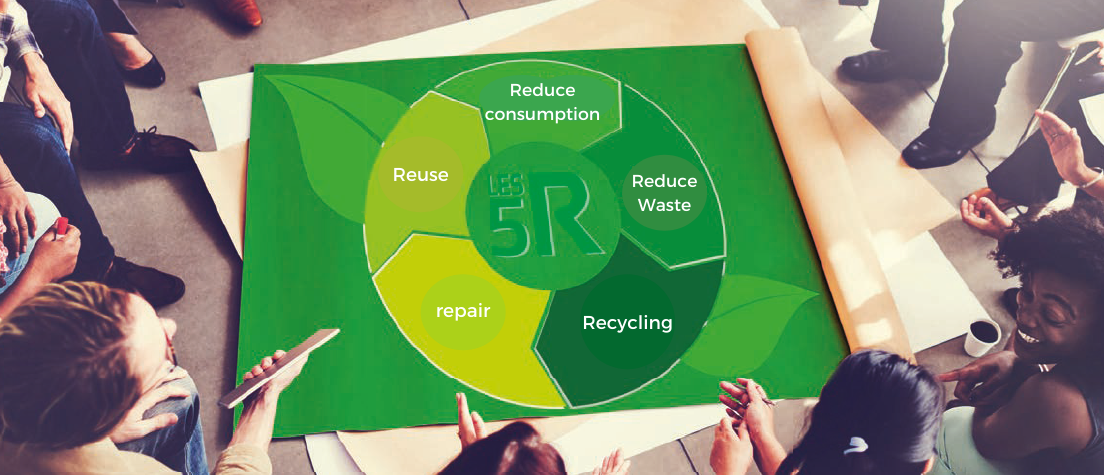7 good practices in sustainble procurement
Consumers, NGO, large companies and agencies are all increasingly demanding that social and environmental practices be respected in their activities. The implementation of a sustainable procurement policy allows you to concretely implement sustainable development within your organisation. Discover the 7 best practices to integrate a sustainable procurement policy effectively in your organisation.
1-Raise awareness internally about the issues and train the teams
Raising awareness and training your teams is a crucial step in launching a sustainable purchasing policy in your company.
1- Promote global action
Through a responsible purchasing policy based on the values of the company or community and its willingness to be fully involved in positive change.
2- Organise an increase in skills on this subject.
This requires the involvement of all employees, for whom at least one day of training must be planned, followed by feedback from them and a sharing of their ideas and questions.
3- This involvement must enable synergy between the purchasing department and all departments
It is about self-regulation and sharing knowledge on all aspects of procurement. In addition, what is usually thrown away by one department can be more systematically reused or recycled by another.
2-Implement an internal charter for a responsible purchasing policy and circular purchasing
A responsible purchasing charter, signed by all employees, makes it possible to establish a general framework and to take certain actions into account immediately. In particular, it is a matter of systematising one choice rather than another, for a recycled or remanufactured product after sourcing. It must also establish objectives and commitments for all the players in the value chain. This charter is not only dedicated to the company's personnel, it must also be transmitted to suppliers who will be able to use it to propose new processes and products.
The charter includes :
- The definition of the problems and the objectives
- The internal reference system and the choices to be made on a daily basis
- The commitments of each person
- The monitoring policy with a timetable and indicators to show progress
- The responsible purchasing contractualisation policy (such as purchase-purchase or purchase-resale agreements that define the end-of-life of a product with the supplier)
3-Analyse the life cycle of the products you buy
A responsible purchasing policy means anticipating the end of life of products. It is necessary to find out whether, once used, they will be bought back or resold by the supplier and under what conditions, in view of the possibilities of recycling or reuse. Or, if this is not possible, how they will be disposed of and with what consequences for energy consumption and CO2 emissions. This can thus be the subject of a specific contract.
4-Analysing the conditions beforehand
Production conditions are an integral part of a coherent responsible purchasing policy. It is therefore necessary to question suppliers and check precisely what the production method is, to which must be added the working conditions and the materials used (their energy consumption, their possible degree of pollution, their harmlessness).
Biodegradable or recyclable materials should be favoured, as well as their reparability rate. As for packaging, cardboard should take precedence over plastic. Generally speaking, over-packaging should be avoided.

5-Anticipating in responsible purchasing
Anticipating responsible purchasing means first of all identifying the circular economy offer available locally through a sourcing (or benchmark) of companies in the sector. In addition, it is always necessary to prefer reuse to new products and to choose eco-designed products. Furthermore, it is preferable to start with small actions, to see that it works, and then to progress in this way, rather than starting large projects that do not succeed.

6-Develop reciprocity with suppliers towards the same goals
A responsible purchasing policy is a collaborative approach with its suppliers. What benefits the company must also benefit them and their partners. The reciprocity of the circular economy allows us to innovate together towards the same leverage effect. With a better quality of production, companies and suppliers actually provide a better offer. Together, they contribute to reducing their environmental impact and create better working conditions. As a result, they improve their image together on a genuine basis.
On 1 October 2017, the RFAR replaced the Responsible Supplier Relations Label (RFR) created in 2012. This official distinction certifies companies that have built a sustainable and responsible relationship with their suppliers. The RFAR is part of the Responsible Supplier Relationship Charter, which has around 2,000 signatory companies committed to this approach.
- To ensure financial fairness towards suppliers
- Encourage collaboration between major clients and strategic suppliers
- Reduce the risks of reciprocal dependence between principals and suppliers
- Involve major clients in their sector
- Assessing the total cost of the purchase
- Integrate environmental issues
- Ensuring the territorial responsibility of your company
- Purchasing: a function and a process
- A purchasing function responsible for the overall management of supplier relations
- Establishing a coherent policy for the remuneration of buyers
7-What indicators should be used to monitor progress?
Key performance indicators - KPIs - allow you to monitor your progress in implementing your sustainable procurement policy. The following indicators can inspire you.
Internally :
- The percentage of your employees who have signed up for a sustainable purchasing policy
- The number/percentage of employees trained
- The economic gain made possible by purchasing in the circular economy
- The share of responsible products
Externally (suppliers)
- The percentage that have signed your charter
- The percentage meeting your environmental and social criteria
- The percentage of suppliers with a label

